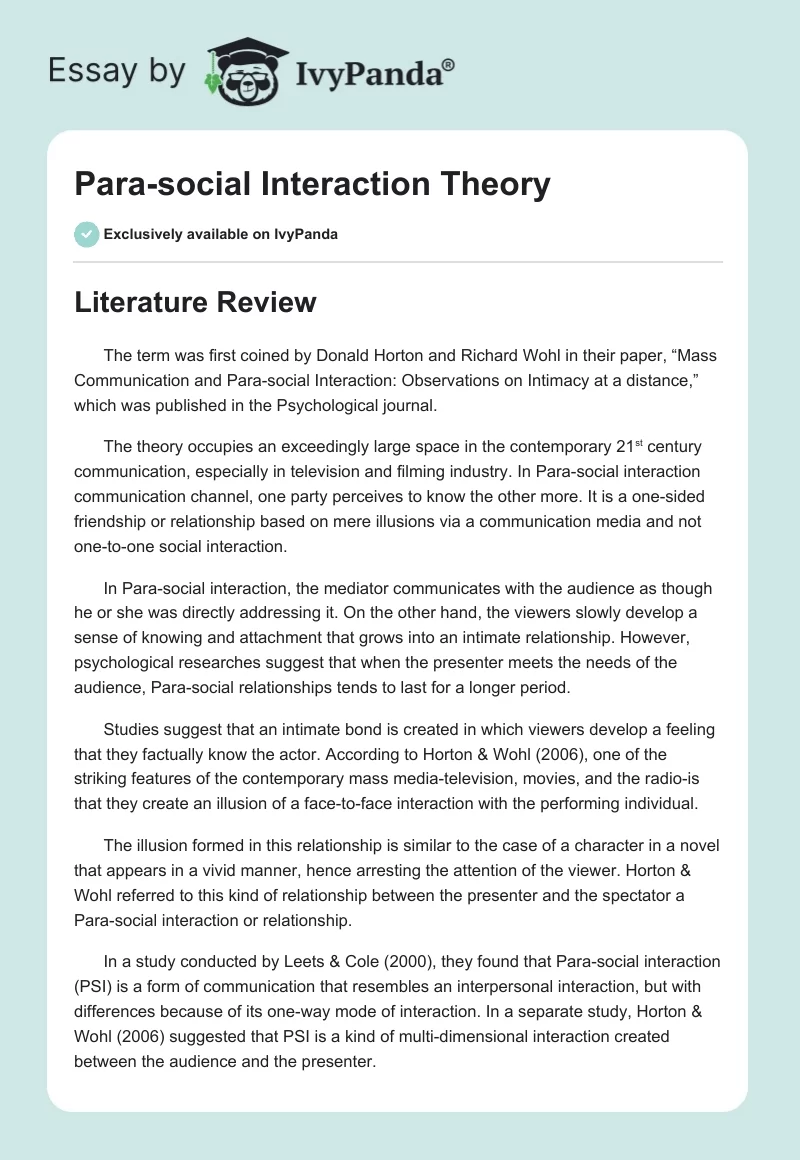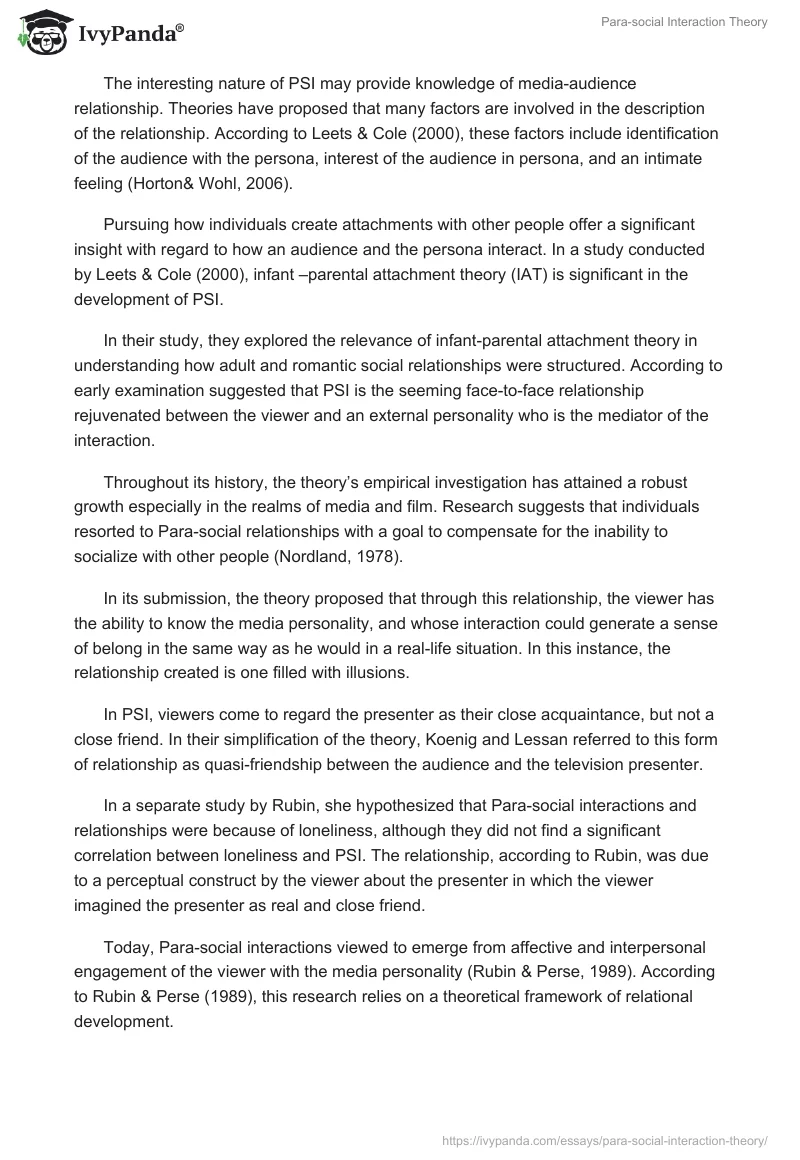Literature Review
The term was first coined by Donald Horton and Richard Wohl in their paper, “Mass Communication and Para-social Interaction: Observations on Intimacy at a distance,” which was published in the Psychological journal.
The theory occupies an exceedingly large space in the contemporary 21st century communication, especially in television and filming industry. In Para-social interaction communication channel, one party perceives to know the other more. It is a one-sided friendship or relationship based on mere illusions via a communication media and not one-to-one social interaction.
In Para-social interaction, the mediator communicates with the audience as though he or she was directly addressing it. On the other hand, the viewers slowly develop a sense of knowing and attachment that grows into an intimate relationship. However, psychological researches suggest that when the presenter meets the needs of the audience, Para-social relationships tends to last for a longer period.
Studies suggest that an intimate bond is created in which viewers develop a feeling that they factually know the actor. According to Horton & Wohl (2006), one of the striking features of the contemporary mass media-television, movies, and the radio-is that they create an illusion of a face-to-face interaction with the performing individual.
The illusion formed in this relationship is similar to the case of a character in a novel that appears in a vivid manner, hence arresting the attention of the viewer. Horton & Wohl referred to this kind of relationship between the presenter and the spectator a Para-social interaction or relationship.
In a study conducted by Leets & Cole (2000), they found that Para-social interaction (PSI) is a form of communication that resembles an interpersonal interaction, but with differences because of its one-way mode of interaction. In a separate study, Horton & Wohl (2006) suggested that PSI is a kind of multi-dimensional interaction created between the audience and the presenter.
The interesting nature of PSI may provide knowledge of media-audience relationship. Theories have proposed that many factors are involved in the description of the relationship. According to Leets & Cole (2000), these factors include identification of the audience with the persona, interest of the audience in persona, and an intimate feeling (Horton& Wohl, 2006).
Pursuing how individuals create attachments with other people offer a significant insight with regard to how an audience and the persona interact. In a study conducted by Leets & Cole (2000), infant –parental attachment theory (IAT) is significant in the development of PSI.
In their study, they explored the relevance of infant-parental attachment theory in understanding how adult and romantic social relationships were structured. According to early examination suggested that PSI is the seeming face-to-face relationship rejuvenated between the viewer and an external personality who is the mediator of the interaction.
Throughout its history, the theory’s empirical investigation has attained a robust growth especially in the realms of media and film. Research suggests that individuals resorted to Para-social relationships with a goal to compensate for the inability to socialize with other people (Nordland, 1978).
In its submission, the theory proposed that through this relationship, the viewer has the ability to know the media personality, and whose interaction could generate a sense of belong in the same way as he would in a real-life situation. In this instance, the relationship created is one filled with illusions.
In PSI, viewers come to regard the presenter as their close acquaintance, but not a close friend. In their simplification of the theory, Koenig and Lessan referred to this form of relationship as quasi-friendship between the audience and the television presenter.
In a separate study by Rubin, she hypothesized that Para-social interactions and relationships were because of loneliness, although they did not find a significant correlation between loneliness and PSI. The relationship, according to Rubin, was due to a perceptual construct by the viewer about the presenter in which the viewer imagined the presenter as real and close friend.
Today, Para-social interactions viewed to emerge from affective and interpersonal engagement of the viewer with the media personality (Rubin & Perse, 1989). According to Rubin & Perse (1989), this research relies on a theoretical framework of relational development.
There are three theoretical perspectives that explain the creation of Para-social relationships. According to Perse and Rubin (1989), one perspective that explores the formation of PSI is the uncertainty reduction theory advanced. It proposes that relationships between audience and media personality develop over time via a steady process of advanced certainty. Using this analogy, the perspective asserts that an individual’s perception of reduction in uncertainty causes an increased liking of the viewer about the media personality.
PSI suggests that the relationships built through a process where the parties in an interaction continuously learn about each other’s character. Reduced uncertainty leads to an increased and deeper state of intimacy attained by the viewer towards the mediated personalities.
The second perspective that explains the development of this theory is the personal construct theory. In their study, Perse and Rubin (1989) observed that individual’s ability to apply his or her constructs system enables one to make sense of his or her world. The last perspective utilized to explain the development of PSI is the social exchange theory. The theory proposes that individuals assess the benefits of the relationships against the costs. Where the costs exceed the benefits, the relationship may not survive.
In a research conducted by (Horton& Wohl (2006), Para-social develop from an association of the cost and reward in which the viewer connects intimacy and the costs plus benefits that accrue. The systematic assessment of the cost-benefit analysis results in a mental construct that influences the nature of relationship formed thereafter. In simpler terms, a strongly intimate relationship occurs where the viewer’s perception results in a low cost as compared to the rewards.
Research suggests that insecurely attached individuals seek to satisfy their social and interaction needs through a series of social outlets. Kirkpatrick & Shaver (1990) suggested that Para-social relationships serve as a way of safeguarding those deprived of their social needs. Research documents that the theory of Para-social interaction has abundant application in a real-life situation.
In a survey conducted by Kirkpatrick, he suggested that individual’s engagement in religious association serves as a social compensation for those persons insecurely attached (Kirkpatrick 1997). This study shows that Para-social relationships act as a means of healing to individuals suffering from anxiety and loneliness.
Many studies provide literature to believe that Para-social relationships function in the same manner in real-life relationships through attachment behavior. Using various groups of attachment, Kirkpatrick found that non-avoidant women and anxious men resorted to Para-social relationships. Therefore, Para-social interactions play a significant role in compensating individuals anxiously attached to the presenter.
References
Cole, T., & Laura Leets. (2000). Attachment styles and Intimate television viewing: Insecurely forming relationships in a Para-social way. Journal of social and personal Relationships 16(4), 1-25.
Horton, D., & Wohl, R. (2006). ‘Mass Communication and Para-Social Interaction: Observations on Intimacy at a Distance’, 3(1).
Kirkpatrick, L. A., & Shaver, P. R. (1992). An attachment-theoretical approach to romantic love and religious belief. Personality and Social Psychology Bulletin, 18, 266–275.
Nordland, J. (1978). Media interaction. Communication Research, 5, 150–175.
Perse, E., & Rubin, R. (1989). Attribution in social and Para-social relationships. Communication Research, 16, 59–77.
Shaver, P., & Hazan, C. (1987). Being lonely, falling in love: Perspectives from attachment theory. Special Issue: Loneliness: Theory, research, and applications. Journal of Social Behavior and Personality, 2, 105–124.


